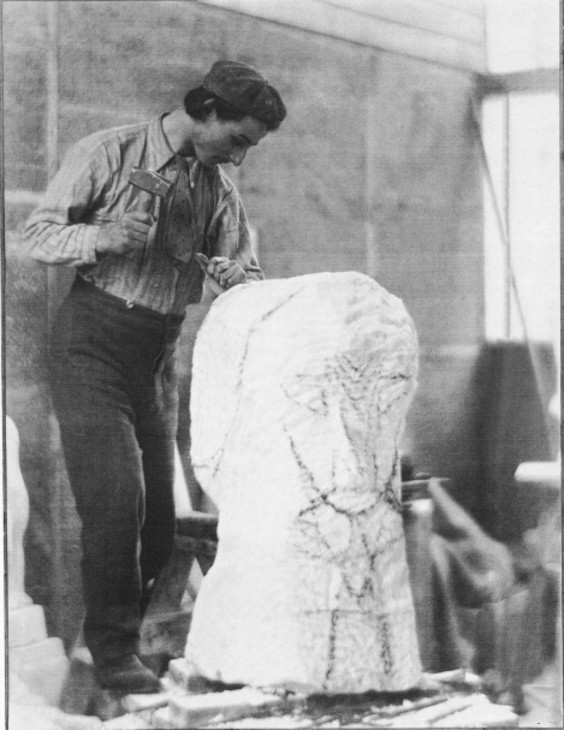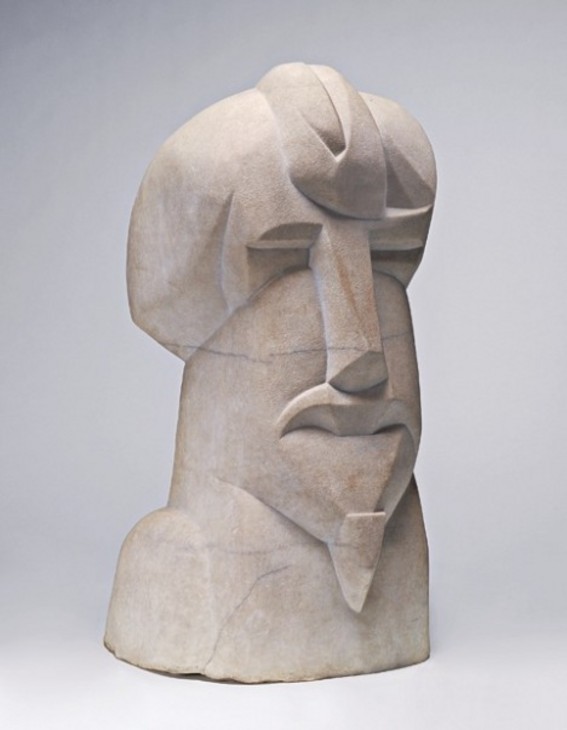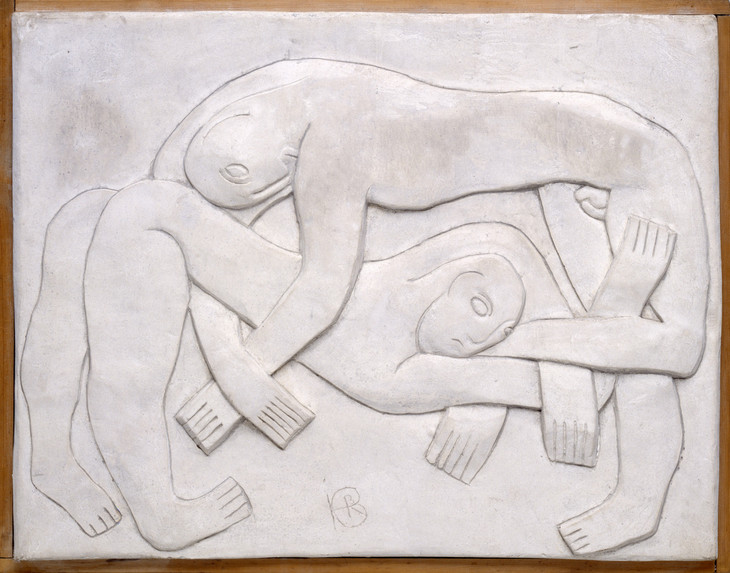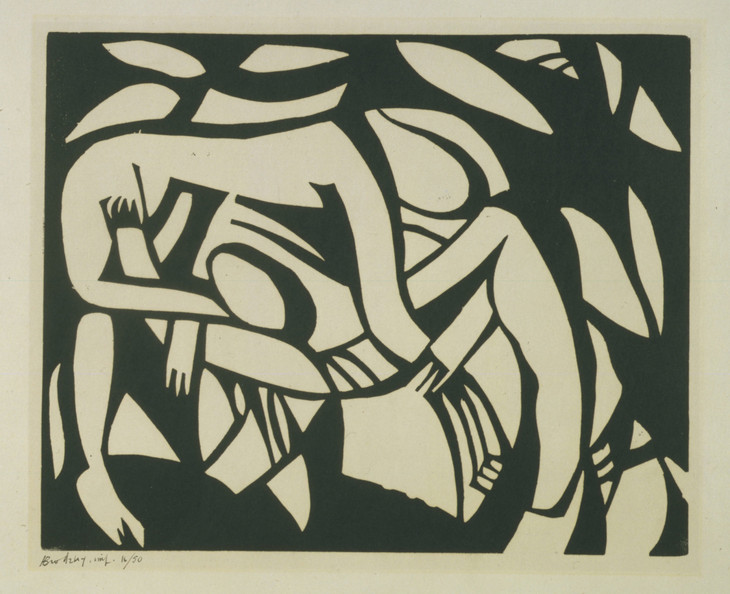The Plaster and its Cast
Henri Gaudier left his native France in 1911 in search of work as an artist and to avoid military service, then compulsory for young men. He arrived in London with his Polish partner, Zofia – or in anglicised form, Sophie – Brzeska. They did not marry but lived together, often describing themselves as brother and sister to others, and unusually combined their names to form the surname ‘Gaudier-Brzeska’. It was under this name that the sculptor exhibited and signed his work, and his friends, patrons and colleagues generally referred to him by this name, or sometimes simply Brzeska.
Gaudier-Brzeska had a precocious talent but he did not attend art school and was largely self-taught as an artist, aside from some evening classes in drawing. He led an impoverished existence but was in contact with leading avant-garde figures including the poet Ezra Pound, the sculptor Jacob Epstein (both of whom were American), the painter and writer Wyndham Lewis and the art critic and painter Roger Fry. He lived in London until he returned to France in 1914, aged twenty-three, to enlist in the French army. An infantry sergeant, he was killed fighting in the trenches in northern France on 5 June 1915. Many friends, especially his close ally Ezra Pound, mourned the brevity of his career, observing shortly after the sculptor’s death, ‘we have lost the best of our young sculptors and the most promising. The arts will incur no worse loss in the war than this is.’1
Pound directed the posthumous critical reputation of Gaudier-Brzeska as a sculptor at the vanguard of European modernism, killed before reaching the prime of his career. He published his Memoir of the sculptor in 1916 and organised the Gaudier-Brzeska Memorial Exhibition at the Leicester Galleries in London in 1918. Other memoirs and biographies were released in the 1920s and 1930s, most notably Jim Ede’s book Savage Messiah (1930 and 1931), blurring the realities of Gaudier-Brzeska’s career with myths and legends and creating from his life something of a ‘bohemian melodrama’, according to the art historian Evelyn Silber.2 These accounts coincided with a wave of interest in Gaudier-Brzeska’s work by a new generation of sculptors such as Henry Moore, Barbara Hepworth and Frank Dobson, who were drawn to Gaudier-Brzeska’s technique of carving directly into stone, wood, plaster and other materials. While the Frenchman’s reputation has rested largely on his stone carvings, in recent years art historians and curators have returned to Gaudier-Brzeska’s small but impressive output of sculptural works in a range of materials including plaster, wood, bronze and brass, as well as his drawings and a handful of paintings and texts written for the leading avant-garde journals of the time. The focus of this project, the carved plaster relief Wrestlers (fig.1), throws new light onto the innovative ways in which he experimented with sculptural materials at the beginning of the twentieth century.
Uncertainty surrounds the dating of Wrestlers. Some experts believe on formal grounds that the carving must have been made in 1913, but Gaudier-Brzeska included the work in his handwritten ‘List of Works’ under 1914 as ‘lutteurs, bas relief, modelage directe en plâtre’ (‘wrestlers, bas relief, modelled directly in plaster’).3 Pound also recalled seeing the finished version of the relief on one of his visits to the artist’s studio in Putney, west London, in 1914 while he was having his portrait bust carved (figs.2–3):
An infant Hercules in grey stone had been broken in moving to this studio. The head rolled about the floor, a round object about half the size of a fist, it was one of the kitten’s playthings. There was the large bas-relief of the wrestlers, some old work in one corner, the small forge, a representational bust, clay, in the manner of Rodin which he had, thank Heaven, discarded.4

Walter Benington
Henri Gaudier-Brzeska carving Hieratic Head of Ezra Pound c.1914
Photo: Benington archive
Fig.2
Walter Benington
Henri Gaudier-Brzeska carving Hieratic Head of Ezra Pound c.1914
Photo: Benington archive

Henri Gaudier-Brzeska
Hieratic Head of Ezra Pound 1914
Courtesy National Gallery of Art, Washington
Fig.3
Henri Gaudier-Brzeska
Hieratic Head of Ezra Pound 1914
Courtesy National Gallery of Art, Washington
Although offering no precise information about the work’s date, another friend of Gaudier-Brzeska, the artist Horace Brodzky, also wrote about Wrestlers. In his memoir of Gaudier-Brzeska, published in 1933, Brodzky described its genesis and early construction:
At the beginning of our friendship, in addition to carving and modelling, he was also painting in oils, and making pastels, drawings and etchings. At this time he showed me a painting of a Whitechapel Jewish fruit-seller. It was painted with anything but an economy of paint. In fact he must have had Van Gogh in mind, and he applied the paint in an extravagant manner. The painting displeased him and one evening at his studio I was asked to scrape it down. I then reversed the canvas on the stretcher. On my next visit I noticed that he has commenced to paint an imaginative tropical landscape, hot in colour, with a dull red sky and exotic trees, all very Gauguinesque. This also displeased him and was later abandoned, and the canvas was covered with a thin coat of plaster. On this Brzeska carved two wrestling figures ... This subject was one that he used more than once. He made drawings of the subject, also a lino-cut [fig.4].5
Conventionally, plaster is used in the preliminary stages of making a sculpture, for example, the construction of plaster moulds used in the bronze-casting process or the fashioning of maquettes. Gaudier-Brzeska, however, frequently used plaster for finished pieces of work, even ones on a large scale.6 His reasons were largely economic: household plaster was cheap and easily available. Gaudier-Brzeska’s poverty was frequently remarked upon by his contemporaries: he lacked money not only for materials but also for daily necessities. For a sculptor who often resorted to stealing bits of stone from cemeteries or waiting for off-cuts from his studio-neighbour Aristide Fabrucci, sourcing a flat piece of stone for Wrestlers was out of the question. However, plaster also possesses qualities that are ideal for the untrained sculptor. Until this point Gaudier-Brzeska had predominantly modelled in clay but wanted to learn how to carve in the manner of sculptors he admired such as Jacob Epstein in London and Constantin Brancusi in Paris. Under the sharp edge of the chisel, plaster came away easily. This allowed Gaudier-Brzeska, who had not been to art school or served an apprenticeship with another sculptor, to experiment with the skills and processes needed to carve directly into the material in a way that the resistant surfaces of stone did not.

Henri Gaudier-Brzeska
Portrait of a Whitechapel Jew c.1913
Oil paint on canvas
915 x 711 mm
Museum of Fine Arts, Boston
Fig.5
Henri Gaudier-Brzeska
Portrait of a Whitechapel Jew c.1913
Museum of Fine Arts, Boston
Once satisfied with the result of his labours, Gaudier-Brzeska carved his monogram in the centre of the empty ground underneath the fighting wrestlers. There was no more scraping down or layers, and no need to reverse the support in order to add other materials. The work was, for the time being, finished. Wrestlers remained in the studio after it was completed. In Gaudier-Brzeska’s ‘List of Works’ the columns where he added the price the work was sold for and the name of the buyer remain empty in the case of this piece. But it might be that the work was not made to be sold and that it was a work done for personal interest, to test out an idea. Wrestlers left Gaudier-Brzeska’s studio for the first time in 1918 when it was exhibited at the memorial exhibition of his work held at the Leicester Galleries in central London.9
Notes
Ezra Pound to Professor Felix E. Schelling, quoted in D. D. Paige (ed.), The Letters of Ezra Pound, 1907–1941, London 1971, p.61.
In Gaudier-Brzeska: Life and Art (1996), Evelyn Silber lists the work as 1913 and warns that Gaudier-Brzeska’s List of Works should be used with caution. However, in the absence of any further information, it seems safest to retain the artist’s own dating. A facsimile of Gaudier-Brzeska’s ‘List of Works’ is reproduced in Henri Gaudier-Brzeska dans les Collections du Centre Pompidou, Musée national d’art moderne, Paris 2009, p.170–93.
See, for example, Bird Swallowing a Fish c.1913–14 (Tate T00658), which was also carved in plaster and last cast by John W. Mills in the 1960s. Silber notes that ‘Gaudier’s List of Works mentions only a plaster of this piece but a bronze piece had also been made and was exhibited in the London Salon’ (1996, p.273). It has been suggested that up to three bronze casts were made from the original plaster during Gaudier-Brzeska’s lifetime but this is now impossible to verify. Ede also had six bronzes cast from the original plaster by Fiorini and patinated by Henry Moore in 1964. Ede then had a further four casts made by John W. Mills.
How to cite
Sarah Victoria Turner, ‘The Plaster and its Cast’, July 2013, in Sarah Turner (ed.), In Focus: 'Wrestlers' 1914, cast 1965, by Henri Gaudier-Brzeska, Tate Research Publication, July 2013, https://www


